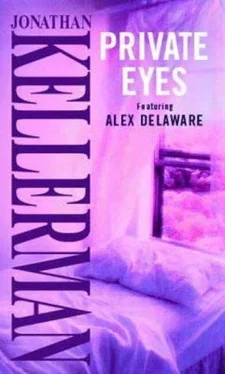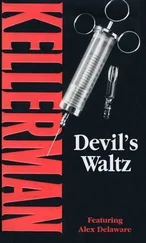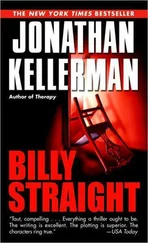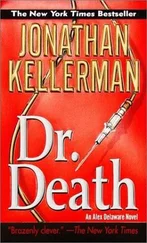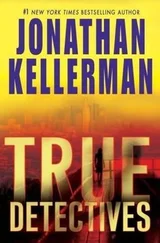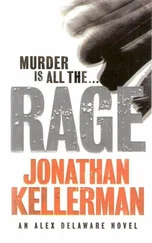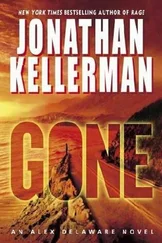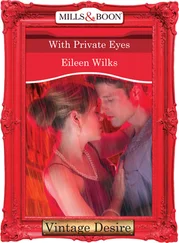Melissa touched the boy’s sleeve and said, “Let’s get out of here.”
Ramp said, “Where are you going?”
Melissa said, “Out. To look for her.”
Ramp said, “Do you really think-”
“Yes, I do. C’mon, Noel.” Tugging at the red fabric.
The boy looked at Ramp.
Ramp turned to me. I played sphinx. Ramp said, “Okay, Noel, consider yourself off for the rest of the night. But be careful-”
Before he finished the sentence the two of them were out the door. It slammed shut and echoed.
Ramp stared at it for a few moments, then turned to me, weary. “Would you care for a drink, Doctor?”
“No, thanks. I’m expected at the Gabney Clinic.”
“Yes, of course.”
He walked me to the door. “Have kids of your own, Doctor?”
“No.”
That seemed to disappoint him.
I said, “It can be tough.”
He said, “She’s really bright- sometimes I think that makes it rougher, for all of us, her included. Gina told me you treated her years ago, when she was just a little kid.”
“Seven through nine.”
“Seven through nine,” he said. “Two years. So you’ve spent more time with her than I have. Probably know her a hell of a lot better than I do.”
“It was a long time ago,” I said. “I saw a different side of her.”
He smoothed his mustache and played with his collar. “She’s never accepted me- probably never will. Right?”
“Things can change,” I said.
“Can they?”
He opened the door on Disney lights and cool breeze. I realized I hadn’t gotten directions to the clinic from Melissa and told him so.
He said, “No problem. I know the way by heart. Gone there plenty. When Gina needed me to.”
On the way to Pasadena I found myself peering up driveways, checking foliage, scanning the streets for a misplaced shadow, a flash of chrome. The crumpled outline of a woman down.
Irrational. Because the pros had been there already: I spotted three San Labrador police cruisers within a ten-block radius, one of which tailed me for half a block before resuming its prowl.
Irrational because the streets were naked- a stray tricycle could be spotted a block away.
A neighborhood that kept its secrets off the street.
Where had Gina Ramp taken hers?
Or had they been taken from her?
Despite my words of encouragement to Melissa, I hadn’t convinced myself the whole thing was an impromptu vacation from phobia.
From what I’d seen, Gina had been vulnerable. Fragile. Just arguing with her daughter had set off an attack.
How could she possibly handle the real world- whatever that meant.
So I kept searching as I drove. Spitting in the face of reason and feeling a little better for it.
***
The Gabney Clinic occupied a generous corner lot in a good residential neighborhood that had begun yielding reluctantly to apartments and shops. The building had once been a house. A big two-storied, shingle-sided, brown craftsman-style bungalow set back behind a flat, wide lawn. Three giant pines shadowed the grass. A front porch spanned the width of the structure, darkened by massive eaves. Shake roof, lots of wood-relief, stingy windows in oversized casements. Ungainly and dimly lit- some architectural hack’s sendup of Greene and Greene. No sign advertising what went on inside.
A low wall- rock chips in cement- fronted the property. A gateless gap in the center provided access to a cement walkway. On the left, a wood-plank gate had been propped open, exposing a long, narrow driveway. A white Saab Turbo 9000 was parked at the mouth of the drive, blocking further motor access. I left the Seville parked on the street- Pasadena was more tolerant than San Labrador- and made my way up the walk.
A white porcelain sign the size and shape of an hour cigar was nailed to the front door; GABNEY was painted on it in black block letters. The knocker was a snarling lion chewing on a brass ring, top-lit by a yellow bug bulb. I lifted it and let it fall. The door vibrated- C-sharp, I was pretty sure.
A second porch light went on. A moment later the door opened. Ursula Cunningham-Gabney stood in the doorway wearing a burgundy-colored scallop-necked knit dress that ended two inches above her knees and accentuated her height. Vertical ribs ran through the fabric, accentuating further. High-heeled pumps were the topper.
The perm she’d worn in the newspaper photo had been replaced by a glossy fudge-colored wedge. John Lennon eyeglasses hung from a chain around her neck, competing for chest-space with a string of pearls. The chest itself was convex and concave exactly where it should have been. Her waist was small, her legs sleek and very, very long. Her face was squarish, finely molded, much prettier than in the picture. Younger, too. She didn’t appear to be much older than thirty. Smooth neck, tight jawline, big hazel eyes, clean features that didn’t need camouflage. But she was wearing plenty: pale foundation, artfully applied blush, mauve eye shadow, deep-red lipstick. Aiming for severe and hitting the target.
“Dr. Delaware? Come in.”
“Alex,” I said. “Fair is fair.”
That confused her for a moment; then she said, “Yes, of course. Alex.” And smiled. And turned it off.
She motioned me into what would have seemed like a generous entry hall if I hadn’t just done time at Dickinson Manor. Parquet floors, architecturally paneled oak walls stained shoe-polish brown, plain-wrap craftsman benches and coat trees, a clock that said SANTA FE below the 12 and RAILROAD above the 6. On the walls was a scattering of muddy California plein-air landscapes- the kind of stuff the galleries in Carmel had been trying to palm off as masterpieces for years.
The living room was to the left, visible through half-open sliding wooden doors. More oak walls, more landscapes- Yosemite, Death Valley, the Monterey coast. Black-upholstered straight-backed chairs arranged in a circle. Heavy drapes hid the windows. What would have been the dining room was to the right, set up as a waiting area with mismatched couches and magazine tables.
She stayed a couple of steps in front of me, heading for the rear of the first floor. Quick, deliberate steps. Tight dress. Fluid glutei. No chitchat.
She stopped, opened a door, and held it.
I stepped into what had probably been a maid’s room. Small and dim and gray-walled, with a low ceiling. Furnished with simple contemporary pieces: a low-backed pine and gray-leather stenographer’s chair behind a pine table-desk. Two side chairs. Three bracketed shelves full of textbooks on the wall behind the desk. Diplomas filling the wall to the left. A single window on a side wall was covered by a gray pleated shade.
A single piece of art, next to the shelves. Cassatt drypoint etching. Soft color. Mother and child.
Yesterday I’d seen another piece by the same artist. Another simple gray room.
Therapeutic rapport taken to the nth?
Chicken-egg riddles jumped into my head.
Ursula Cunningham-Gabney went behind the desk, sat, and crossed her legs. The dress rode up. She left it that way. Put on her glasses and stared at me.
She said, “No sign of her yet?”
I shook my head.
She frowned, pushed the glasses higher on her thin, straight nose. “You’re younger than I expected.”
“Ditto. And you squeezed in two doctorates.”
“It really wasn’t that remarkable,” she said. “I skipped two grades in elementary school, started Tufts at fifteen, went to Harvard for grad school at nineteen. Leo Gabney was my major professor and he guided me through- helped me avoid some of the nonsense that can trip a person up. I did a double major in clinical and psychobiology- had taken all the premed courses as an undergrad. So Leo suggested I go to med school. I did my dissertation research during the first two years, combined my psych internship with my psychiatric residency, and ended up with licensure in both fields.”
Читать дальше
